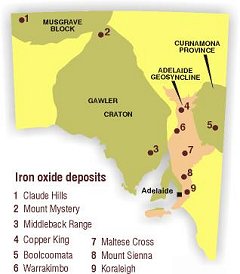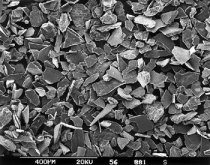 Natural Iron oxide and hydroxide minerals occur in a variety of colours and have been used as pigments since prehistoric times. In France and northern Spain, cave paintings using iron oxide pigments have been dated at ~30 000 years and, in Australia, Aborigines mined ochre which was transported throughout the continent via an extensive nationwide trade network. Wilgie Mia red ochre deposit in the Weld Range, Western Australia, is a well-documented example, and the Bookartoo red ochre deposit in the northern Flinders Ranges is a local example of past Aboriginal mining activity.
Natural Iron oxide and hydroxide minerals occur in a variety of colours and have been used as pigments since prehistoric times. In France and northern Spain, cave paintings using iron oxide pigments have been dated at ~30 000 years and, in Australia, Aborigines mined ochre which was transported throughout the continent via an extensive nationwide trade network. Wilgie Mia red ochre deposit in the Weld Range, Western Australia, is a well-documented example, and the Bookartoo red ochre deposit in the northern Flinders Ranges is a local example of past Aboriginal mining activity.
The principal pigment minerals are:
- haematite,
- Fe2O3 (red)
- magnetite,
- Fe3O4 (brown to black)
- goethite,
- FeOOH.xH2O (yellow)
- lepidocrocite,
- FeOOH.xH2O (yellow).
The chemical industry has developed a wide range of synthetic iron oxide pigments with superior uniformity, colour quality and chemical purity, but natural deposits remain competitive for many applications by virtue of their abundance and low extraction costs.
The principal use of pigment is as a colouring agent in paint, concrete products, building materials, ceramics and paper. Micaceous or specular haematite is a crystalline variety with a platy mica-like habit which finds extensive use in paint for external applications such as bridges, where its lamellar, anticorrosive properties are more important than its colour.
World production is estimated at ~0.4 Mt/year. Significant Australian resources include the Mount Gould micaceous haematite deposit in Western Australia with estimated reserves of 117 000 t, and yellow and brown ochres at Savage River, Tasmania, with reserves estimated at 72 000 t.
South Australian deposits
Micaceous haematite
 Micaceous haematite platelets in a milled sample fraction from Mount Mystery |
The Mount Mystery micaceous haematite deposit, ~50 km northeast of Marla, occurs as a discontinuous outcrop up to 8 m wide with a strike length of 450 m. It was emplaced along a fault separating late Adelaidean sediments from overlying Cambrian Wallatina Formation. In outcrop it is massive, hard and blue. Proven reserves are 30 000 t. A small open-cut development begun in 1995 has yielded 77 t to date.
At Warrakimbo, 90 km northeast of Port Augusta, dolomite of the Adelaidean Etina Formation hosts pods of massive micaceous haematite over a strike length of several hundred metres. These appear to have formed in a fault zone by replacement of a carbonate host. The bulk of the ore occurs in Main Lode which has a strike length of 45 m and maximum thickness 6.5 m. A bulk sample of 676 t, removed for metallurgical testwork in 1977, is the only recorded production. Beneficiation tests have shown the resultant micaceous iron oxide to be of high grade and to meet specifications for the manufacture of rust-resistant paints.
The Koraleigh micaceous haematite prospect, 6 km north of Kersbrook, occurs as a discontinuous unit with a strike length of 680 m and maximum width of 6 m. Calculated resources are 192 000 t at 46.5% Fe2O3. It is of sedimentary origin and has a simple mineralogy of ill-sorted detrital quartz and micaceous haematite.
Ochres
Yellow and red ochres have been mined from the oxidised zone of Adelaidean and Cambrian sediments at a few localities in the Flinders and Mount Lofty Ranges. The total recorded production of 4060 t was intermittent and ceased in 1953. The largest production came from the Copper King Mine, 16 km north of Beltana, where yellow, brown and red ochres were mined from an oxidised zone to 30 m depth. The ore occurs as irregular seams, pockets and veins in an ironstone developed on massive siderite. Yellow and golden ochres were won from ironstone bodies to a depth of 10 m at the Maltese Cross Mine near Oodla Wirra. Yellow ochre was mined from the Mount Sienna ochre mine, 5 km north of Birdwood; the ochre here occurs as a ferruginous gossan developed over a pyrite body and was mined to a depth of 25 m from veins and seams up to 1.5 m wide.
Several deposits of carphosiderite (hydrous iron sulphate) have been worked in the ‘Boolcoomata’ district, ~25 km north of Olary. Small parcels were gently roasted and processed to produce a red ochre.
Nickeliferous ochre has been identified at Claude Hills in the Musgrave Block. Drilling has outlined irregular bodies within ultramafic masses of Giles Complex basic igneous host rocks. Resources have been estimated at 6 Mt.
Many small resources of dark blue-grey and red haematite in the Middleback Range may be suitable as pigment or for processing into pigment.
Additional Reading
Cook, F.W., 1998. Micaceous haematite in South Australia — resources and markets. MESA Journal, 8:14-15.
Hiern, M.N., 1976. Pigments (mineral) — South Australia. In: Knight, C.L. (Ed.), Economic geology of Australia and Papua New Guinea, 4, Industrial minerals and rocks. Australasian Institute of Mining and Metallurgy. Monograph Series, 8:295.
Jack, R.L., 1928. Pigment minerals in South Australia. South Australia. Geological Survey. Bulletin, 13.


